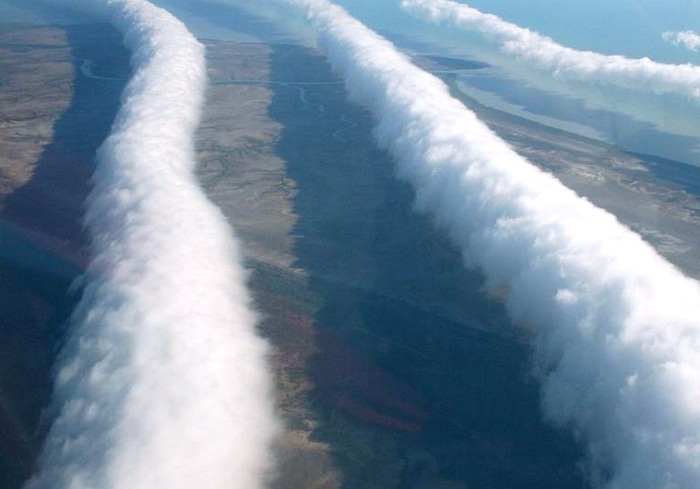There always happens a strange phenomenon involving the weather in the Gulf of Carpentaria in Queensland, Australia. The name given to this phenomenon is called Morning Glory clouds The Morning Glory cloud is a rare meteorological phenomenon consisting of a low-level atmospheric solitary wave and associated cloud, occasionally observed in different locations around the world. The wave often occurs as an amplitude-ordered series of waves forming bands of roll clouds. However, it is believed that due to the configuration of land and sea in the area of the southern part of the Gulf of Carpentaria in Northern Australia plays an important role in the formation of these strange clouds. In the town of Burketown in Queensland, Morning Glory clouds can be observed very close to Earth from late September to early November. These unusual cloud formations have been noticed here since ancient times. The local Garrawa Aboriginal people called it kangólgi. Royal Australian Air Force pilots first reported this phenomenon in 1942. This strange clouds phenomenon of the Gulf of Carpentaria has been studied by multiple teams of scientists since the early 1970s. The first studies were published by Reg H. Clarke (University of Melbourne). The occurrence of these Morning Glory clouds are not clearly understood because its rarity means it has little significance in terms of rainfall or climate.
These clouds are generally formed at the height of 100 to 200 metres above the ground in the shape of long thin stripes. A Morning Glory cloud is a kind of roll cloud (A roll cloud is a low, horizontal, tube-shaped, and relatively rare type of arcus cloud) that can be up to 1,000 kilometres long, 1 to 2 kilometres high. In an aircraft there is a significantly better chance of sighting the cloud. These clouds attracts glider pilots intent on riding this phenomenon. The cloud often travels at the rate of 10 to 20 metres per second. Sometimes there is only one cloud, sometimes there are up to ten consecutive roll clouds. Three distinct types of Morning Glory clouds have been identified. The Morning Glory is often accompanied by sudden wind squalls, intense low-level wind shear, a rapid increase in the vertical displacement of air parcels, and a sharp pressure jump at the surface. In the front of the cloud, there is strong vertical motion that transports air up through the cloud and creates the rolling appearance, while the air in the middle and rear of the cloud becomes turbulent and sinks. The cloud quickly dissipates over land where the air is drier. Morning Glory Clouds are occasionally formed in United States, the English Channel, Munich, Berlin, eastern Russia, and other maritime regions of Australia. But such phenomenon occurs regularly in the Gulf of Carpentaria, Queensland, Australia.
These clouds are generally formed at the height of 100 to 200 metres above the ground in the shape of long thin stripes. A Morning Glory cloud is a kind of roll cloud (A roll cloud is a low, horizontal, tube-shaped, and relatively rare type of arcus cloud) that can be up to 1,000 kilometres long, 1 to 2 kilometres high. In an aircraft there is a significantly better chance of sighting the cloud. These clouds attracts glider pilots intent on riding this phenomenon. The cloud often travels at the rate of 10 to 20 metres per second. Sometimes there is only one cloud, sometimes there are up to ten consecutive roll clouds. Three distinct types of Morning Glory clouds have been identified. The Morning Glory is often accompanied by sudden wind squalls, intense low-level wind shear, a rapid increase in the vertical displacement of air parcels, and a sharp pressure jump at the surface. In the front of the cloud, there is strong vertical motion that transports air up through the cloud and creates the rolling appearance, while the air in the middle and rear of the cloud becomes turbulent and sinks. The cloud quickly dissipates over land where the air is drier. Morning Glory Clouds are occasionally formed in United States, the English Channel, Munich, Berlin, eastern Russia, and other maritime regions of Australia. But such phenomenon occurs regularly in the Gulf of Carpentaria, Queensland, Australia.














0 comments:
Post a Comment